My girls were very young when I brought them here (the newly recreated garden was actually first opened to the public the year before my older daughter was born). I think they liked it just fine, but they knew then as they know now that this garden is my piece of heaven, my slice of tranquility and more importantly - my inspiration.
I do not try to recreate anything like it back home. Our soil is not their soil, our climate is not their climate. And Monet forced his family to help care for his dream. I force no one to pander to mine and so I plant for low maintenance, because the enormity of my own project is great and my time for it -- now not so great.
But Giverny inspires me nonetheless. In some ways all gardeners face the same problems of soil, adequate moisture, nutrients. Of weather. Of falling stalks and leaves that are fodder to numerous pests. (I don't know how they've kept the bunnies and chipmunks away, but they have; and I don't think Giverny is home to a groundhog family like the farmette is.)
And so I keep coming back here. Now that I've discovered Francine and Michel's home, my visits are longer and more frequent. There is nothing like going to the gardens as they opens (without having to leave Paris before dawn, as I did more than once in order to be at the head of the line).
This morning, I read that there will be showers, but not until around noon. Well that's splendid! The gardens are in many ways easier to take in on a cloudy day. The contrasts aren't so intense and your senses reach out for that harmony that can readily be felt in a place like this.
Francine and Michel fix a breakfast for me that is guided by my plea for "simple" and "small." It is in fact perfect. And though they wonder that I should want to eat outside, given that it's just in the low 60sF, I am not daunted by this. Wisconsin (unlike Europe) has a great temperature range between morning and noon and I'm used to cool breakfasts out on the porch.
(Francine wheels the tray out.)

(I eat with a lovely view toward their yard.)
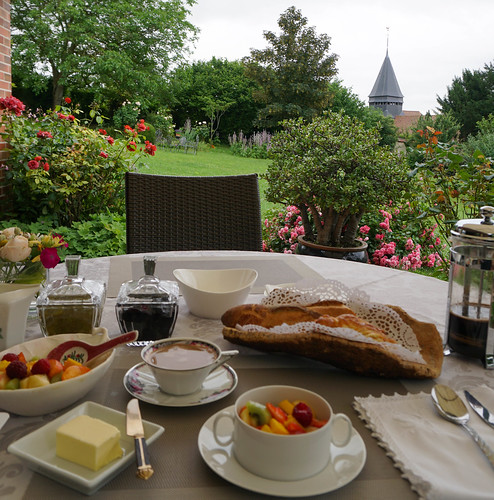
(... where roses bloom.)

And then I hustle over to Monet's Garden, printed ticket in hand, which allows me to budge the (short) line and step right into paradise.
Here's the first big surprise: the crowds in the hour after the opening are modest. Not bad at all! Yes, there are some tour groups, but if you wait patiently, they move on and then you have a moment of respite -- a one on one with the garden. Were people put off by the rain forecast? For the summer season, this is nothing short of wonderful and amazing.
A string of photos will follow. It is a long string. Perhaps today more than most any other time, I take photos as much for myself as for you, since preserving the images helps me feel that they were indeed very real.
If you follow along to the end of the post, you'll have glanced at 42 photos and out of those, 22 will have been from the garden. I suppose that's a wee bit better than back in October where the grand total was 44. I'll be (mostly) quiet now and we can focus together at the beauty of Giverny on July 1st:
Trailing roses and trained upright roses are at the core of Monet's gardens. A rose bush in France will often anchor a row of grape vines in a vineyard. So, too, here, the rose anchors several major alleys.
A few examples:





Perhaps the most important lesson I learned long ago from visiting Giverny is that a garden is a sum total. You may love individual blooms (and I do! daylilies!), but the sensual experience rarely reacts to any one flower. The plants must work in harmony with neighbors to create a portrait of a garden. I took this so to heart long ago, that not only have I build a garden at home based on this idea, but my photos and my writings very much reflect the same thing: yes, there'll be the detail. The flower that's blooming strong. The dessert I baked that day. But to me, far more important is the impression you get from seeing that flower as one of a group that frames the farmhouse, or that dish as being served at a Sunday porch dinner, with everyone participating in the meal. The art comes from imagining how the entirety presents itself -- to me and here, on Ocean, to you, the reader.
The next few photos are, I think, perfect examples of this:



And again, this is not to take away from the love of the individual blossom:

Day lilies!

A busy bee:

And this love of the individual star takes me right to the second garden in the Monet complex -- the water garden. This is where flowers not only play off of each other in that quest for a perfect whole, but they play off the water, the sky -- so that the boundaries grow fuzzy and you are drawn into a canvas that extends beyond just the garden.
So first, a few "individual stars..."


And now, the entirety (and here, having only modest crowds is so very welcome!):


Two more points from this morning visit: last year, to demonstrate how good it is to come at the end of the day to these gardens, I did a couple of time release photos -- something that would be impossible with people milling about. But it's morning now and besides, it's July and not the end of October. Can I still sneak in a time release?
I can.

And finally this reminder: the garden does not stand alone. Not at Giverny and more modestly, not at the farmette. The home has to fit in. You've seen oh so many photos of the farmhouse from all angles, in all seasons. Here's just one of the pink house at Giverny:
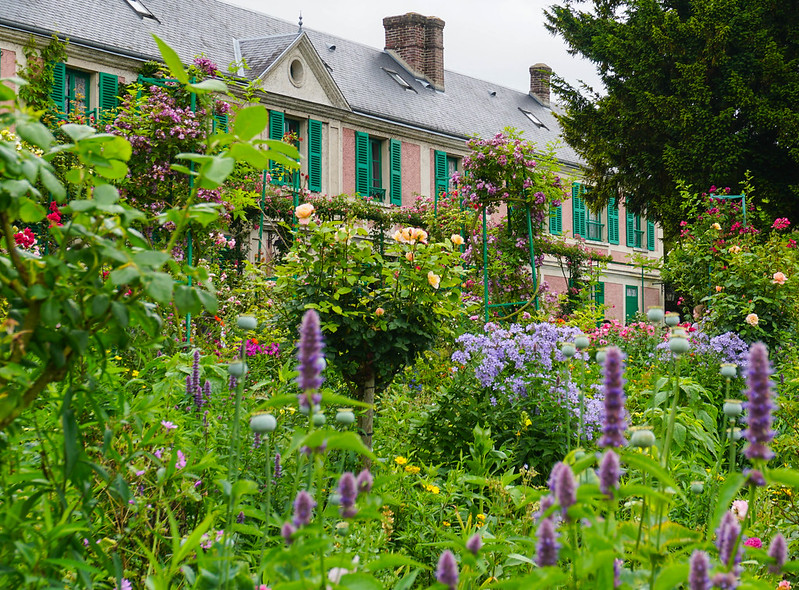
(Things I pick up at the gift shop: a pack of Giverny seeds, some note cards and notebooks, a tshirt for Snowdrop.)

I've had my time with the flowers. I almost want to call it a day, but the hills beckon. Giverny is a village and a rural community and it is small wonder that Monet sometimes took his canvases outside the garden itself. Just as I am surrounded by farmlands back home, so, too, Giverny has agrarian roots. Here's the village from the hill behind it:

Here's the path I follow.

Of course, these days (all days?), Giverny has its quirks. Beyond the conventional prettiness...

There is, for example, a field where a pair of ostriches graze.

I ask Michel -- why ostriches?
He shrugs in a "why not" fashion. The owner loves animals.
I follow a trail that is rather steep and damp, but it does lead me through the forest and up by the fields of wheat. This just brings back memories of Poland and the village where I spent my youngest years. Fields of gold, with the occasional poppies growing wildly therein.

It may as well be my village, though I surely know that poppies growing wildly were a Monet favorite too.
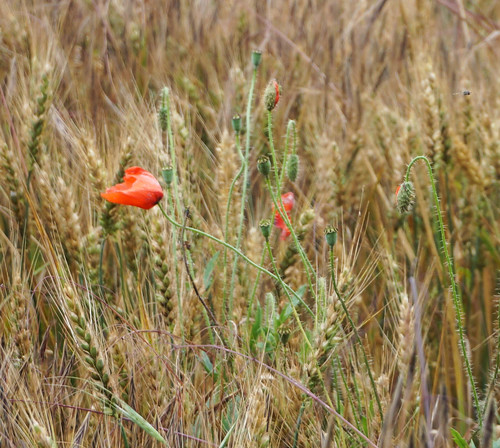
And now I think I have had my fill. I return to Francine's garden...

And I settle in with a cup of tea and I think I'll just stay put, but then I run into Michel and he tells me about a trail to the River Seine and a beach where he takes his grandkids (they have three grandkids and they live right next door!)... I'm off again!
Past the old mill...
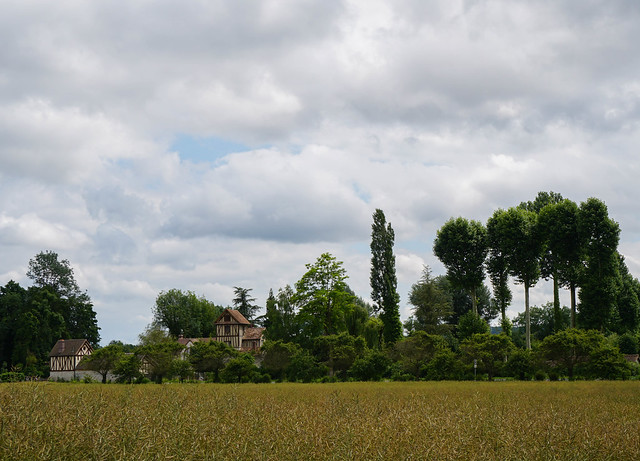
Past grazing sheep (have you ever seen brown sheep??)...
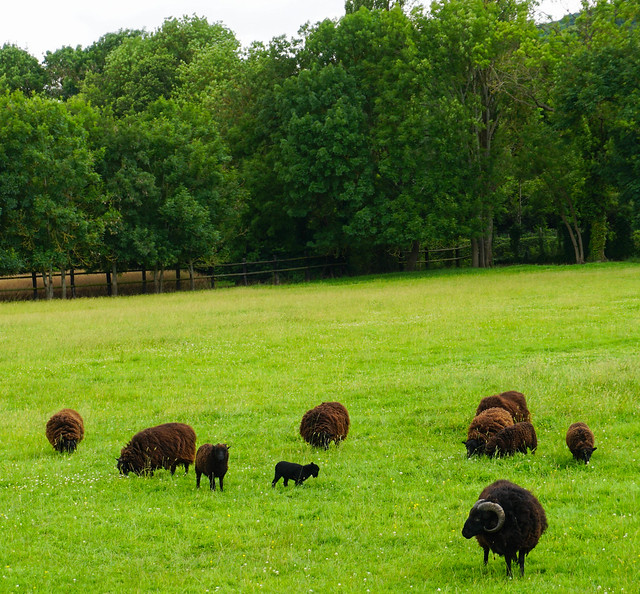
Across fields of gold, speckled by the red poppies...

With a view toward the hill on which Giverny stretches upwards and outwards...

But apart from these pretty pastoral views, the walk is a bust. The road to the river is, in its final stages washed out. The Seine remains high from the spring rains. There is no beach and no easy access to the water's edge.
Never mind, I go back to the village and at the Fondation Claude Monet store, pick up a few stems of (artificial) flowers designed by Emilio Robba. I never liked faked flowers until I bought a little pot of them (same designer) last time I was here. Winter in Wisconsin is long and colorless. Anything that brings these vibrant tones to the table is a good investment.

It's after five now. I'm very close to the entrance to Monet's gardens. Is it accidental? I don't think so. I tell myself that I do not need to go in again. I had a long morning there. I took photos. I reveled in the loveliness of it all. Why go back?
Because it's right there! This mass of beauty! Can you ever have too much beauty in a day?
I do as I did last year: I go up to the guard at the now empty entrance way (no one travels all the way to Giverny to enter the gardens minutes before they close) and I tell him honestly that I already used my ticket to get in once today. Could I possibly come in again to just take another walk? As before, he is agreeable. Allez, allez! -- he ushers me in.
In October, I witnessed the sun sliding beneath the horizon just before 6 (the gardens close every day at 6). Not so now. The light isn't that much different from my visit here in the morning. And yet, the feel of the place is not at all the same. It's nearly empty. It has flushed itself out and now there is that odd handful of people, but mainly the paths are quiet. How totally wonderful! I am alone (or nearly alone) in Monet's garden. It is more than grand -- it is sublime.
I don't take many photos. I've done that already. I waited patiently, people came, people went, the camera did its job.
But I can't resist just a few:
Of the Grand Alee, which only now can be photographed without a single person near it:

Of the little bridge (same thing):
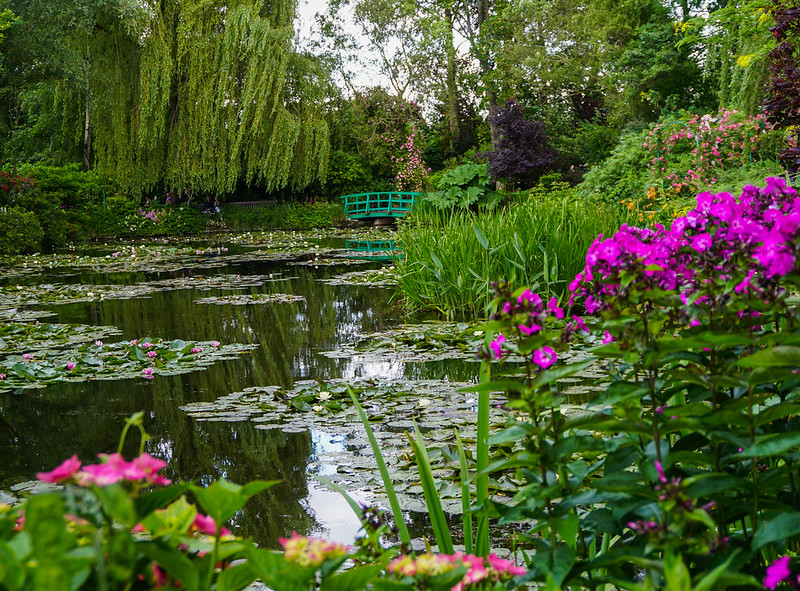
And of the water's reflections, blending into the lilies:

And of one last pathway:
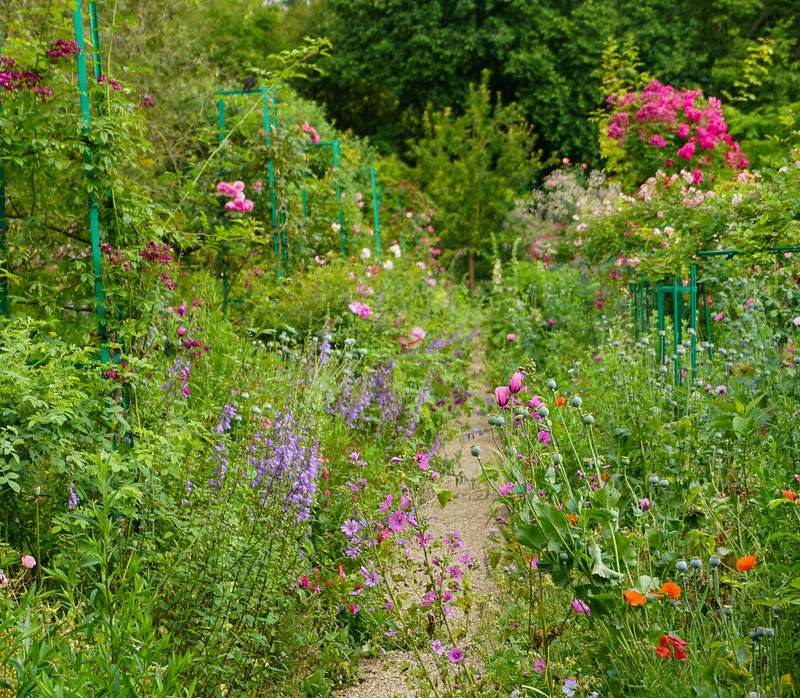
And because it's so quiet here now, I can do that playful nonsense of setting the camera on a time release. And lie down, sit down -- whatever the mood. And wait for the click. And no one will interrupt the shot.

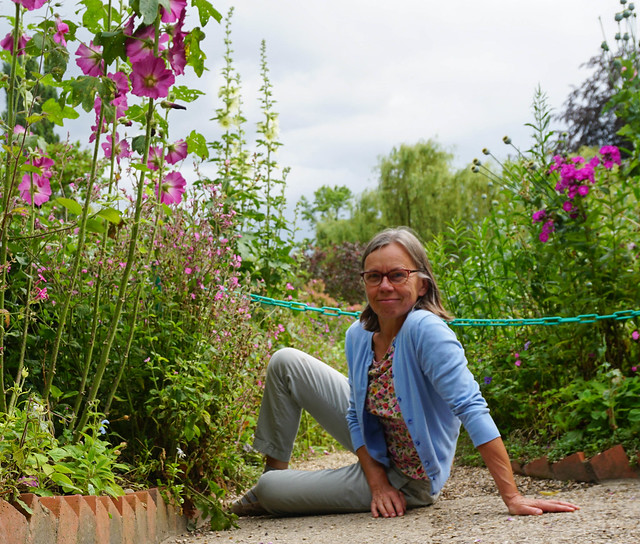
Pants are dirty. Heart is full.
I go to La Musardiere for dinner. Yes, I did this last year too, only now I get to sit outside. First with an aperitif of cassis cider (a Normandy take off on the classic kir, substituting local cider for the white wine).

And a wonderful supper of buckwheat crepes, with local Camembert cheese and apples and an egg.

Oh, and a cafe gourmand (that's an espresso with a sampling of the restaurants desserts, all in miniature):
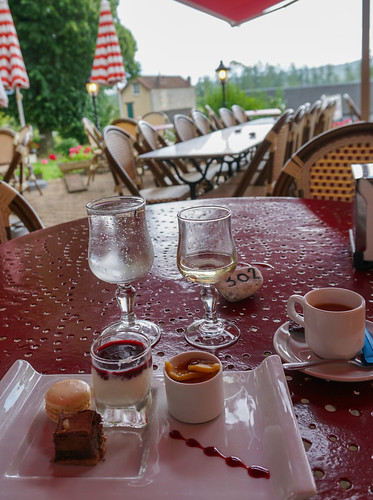
I wont end with a photo of the moon. The rain clouds are back and tomorrow threatens to be a wet day here. No matter. I have a morning train to Paris and then I head south.
But right now, my mind is still reeling with the dazzling images of flowers, blending, fitting in, daring us to think anything but good thoughts about the planet we inhabit.

